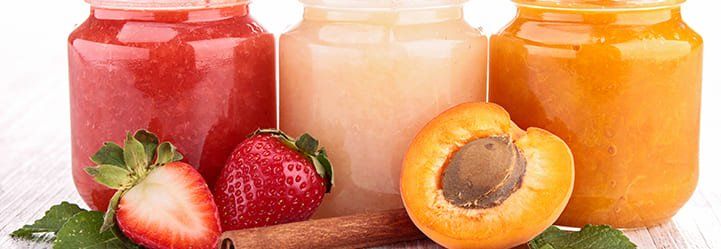Fruit purees, its production process for industry
Alimentos SAS • Apr 21, 2021

Purees are pulp-containing and more viscous than juices. They are one hundred percent fruit and can be made from both fruits and vegetables. Fruit purees are made from uncooked fruit, which has had the skin and seeds removed. After that, the fruit is pulped and mashed into a creamy paste or liquid.
Fruit puree is a semi-finished product, which can be obtained from a large variety of fruits by using the correct technological process. It comes in two forms: single strength or concentrate. Fruit concentrates are thinner in consistency and are often higher in sugars than fruit purees. In this article, we will be discussing the production process of single strength fruit purees and their use in different industries.
The process of making fruit purees
Harvesting and reception
The fruit that goes into purees undergoes a meticulous selection process. The harvested fruit needs to be adequately ripe. It will go through numerous acceptance inspections. The raw fruit is then stored in bins before going through the processing plant.
When it is time to process the fruit, skilled workers offload the fruit – different fruits will be received through a different receiving system – into a drum washer. The fruit needs washing, sorting and some fruits require peeling and pitting.
Extraction, filtration/ homogenization and deaeration
In the extraction process, machines crush the fruit, the juice is separated from the pulp and the seeds are removed through straining. After filtration/ homogenization, certain fruits need to go through a deaeration system. Some fruits are more sensitive to oxidation causing them to change color. To avoid oxidation part of the process takes place in a controlled atmosphere, like a deaeration system, before the final product is packaged.
Pasteurization
It is important to pasteurize, sterilize, the puree before putting it into aseptic packaging. Flash pasteurization involves heating the product briefly at a very high temperature. This is to kill germs to ensure optimal hygiene. The product is then cooled down immediately.
Packaging and storage: retaining the color, flavor and smell of the unprocessed fruit
The puree is packaged in aseptic bags and then placed in a conical steel drum. It has about an 18-month shelf-life. It is important to cover and store the bags in a cool and dry place, protected from moisture and direct sunlight. Once the bag is open it must remain frozen.
When pureeing fruit, it is essential to preserve the organoleptic properties of the pureed fruit – the flavor, smell, color and texture. These properties create an individual experience via the senses for each type of fruit puree. Organoleptic testing of fruit purees involves the assessment of flavor, odor, appearance and mouthfeel of each puree. Storing fruit purees away from heat and humidity is vital in order to maintain the organoleptic properties of the fruit puree.
With process technology, it is possible to obtain the best of the fruit and preserve the original characteristics.
Industries using fruit puree
There are a wide variety of fruit purees available on the market: tropical fruits, exotic fruits, citrus fruits, berries, etc. Fruit puree must be as close as possible to the fresh fruit.
A lot of different industries use these purees. Increasing application of fruit puree in several food-processing sectors is expected to boost the fruit puree demand in the upcoming years. These sectors include bakery, beverage – alcoholic and non-alcoholic – confectionery, baby food, dairy and frozen fruit. It is seen as a healthy alternative to sweeteners and artificial ingredients across the food processing industry.
Fruit products using fruit puree
A large variety of food products contain purees. They are also a popular ready-to-use fruit ingredient used by chefs in:
- Sauces, jams and coulis
- Ice creams and sorbets
- Pies and citrus fruit tarts
- Desserts and mousses
- Coatings and toppings
- Cold soups
- Jelly pastes
Many craft breweries also use fruit puree as the main ingredient for brewing.
Some people with chewing or swallowing difficulties need texture-modified food. Fruit purees can be perfect for that. Providing patients, with swallowing disorders, with the right consistency food is critical.
Fruit Puree Market
The global fruit puree market size was valued at USD 3.86 billion in 2019. It is expected to grow at a compound annual growth rate of (CAGR) of 6% in the next 6 years (Market Analysis Report, 2020). According to a report by Grand View Research, Inc, experts predict that the global fruit puree market size will reach USD 6.16 billion by 2027.
Consumers’ preference towards packaged convenience food at a global level will be driving the market for fruit puree over the coming years. By application, the beverage segment held the largest share of over 30% in 2019. There has been an increased demand for packaged fruit juices due to rapid urbanization.
The baby food segment is expected to witness the fastest growth over the forecast period. The rise in working-class parents has fueled the demand for pre-prepared or processed baby food. Parents are opting for healthier pre-prepared or processed baby food for their babies. This will provide more opportunities for fruit puree to be used in the baby food industry in the coming years.
The Asia Pacific dominated the fruit puree market with a share of 35% in 2019. This is accredited to increasing purchases by consumers and expansion of the food service sector in countries including China and India.
In terms of product, the tropical and exotic segment dominated the market with over 35% share of the global revenue.
In the future improving food-processing technologies will strengthen the production potential of food manufacturers. This in turn will affect the fruit puree demand over the world. Furthermore, the increased need for fruit purees in the above-mentioned sectors is expected to boost the market growth in the future.














